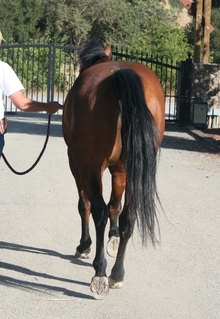A study recently published in the Journal of Veterinary Internal Medicine shows that at least one in 100 horses at some point in its life will lose the ability to control its gait as a result of developing the neurological disorder ataxia.

Examining the gait of a horse
A recent study shows that at least one in 100 horses at some point in its life will lose the ability to control its gait as a result of developing the neurological disorder ataxia.
Once found to be ataxic, the horse is often put down, or undergoes an expensive operation with dubious results. But now researchers from the University of Copenhagen and the Royal Veterinary College in the UK have shown that there is marked disagreement among veterinary surgeons about whether or not a horse is ataxic.
A trip to the veterinarian may prove fatal to a horse, even if it is not necessary to put the animal down. In Europe if the horse is found to be ataxic, which is most often due to the disease 'wobbler syndrome', the horse is likely to be put down immediately. If a horse suffers from this disease, putting it down can be a necessity, as the animal can be dangerous to ride and handle.
This new research from the University of Copenhagen and the Royal Veterinary College in the UK shows marked disagreement among experts about when a horse is ataxic and severity of the ataxia. It is particularly a problem if the ataxia is subtle, as this makes it more difficult to assess.
"It is a problem for both the horse and the owner if the specialists disagree. A horse which could potentially recover might be put down, as an ataxic horse eventually becomes a hazard to the owner due to the risk of a fall during riding or handling," says Emil Olsen, DVM, PhD from the Department of Large Animal Sciences, who headed up the new research.
No scanners for horses
Ataxia caused by Wobbler syndrome affects one in 100 horses, and is one of the greatest sources of missed training days and frustration for horse owners and veterinarians alike. The disease occurs due to pressure on the cervical spinal cord, which can be diagnosed in humans and small animals by MRI or CT scans -- but there are no scanners with a diameter large enough to accommodate a horse's neck and shoulders. The foundation of the veterinarian's assessment is therefore the clinical examination of small changes and irregularities in the horse's gait.
"In this study, specialists in the areas of large animal internal medicine , specialists in equine surgery, and residents evaluated the gait during a neurological examination of 25 horses, and then videos of the horses. They completed a questionnaire, and based on their responses we could see that there was wide disagreement on whether or not they believed a horse was ataxic, and particularly on the severity of the ataxia," says Dr. Emil Olsen.
Quantifiable diagnostics
Horse owners and veterinarians often assume horses with mild ataxia are mildly lame, allowing ataxia to progress to the point of sudden falls during riding or handling. If the disease is discovered when the horse is a foal, treatment options can include restrictive feeding, and at all ages there is a surgery to stabilize the neck by fusing the cervical vertebrae. For horses with ataxia caused by articular process joint (facet joint) osteoarthritis, injecting steroids into the joint can improve the horse's condition for a period of time.
"We hope that our findings will lead to the establishment of clearer definitions for what constitutes normal and abnormal gait patterns in horses, and the relationship between spinal cord disease and ataxia. This could lead to greater agreement among specialists and practicing veterinarians. The current disparity also raises the need for quantitative diagnostics, using equipment that can measure the horse's movements in detail."
If you have a horse you suspect is ataxic, contact your veterinarian for further advice.
